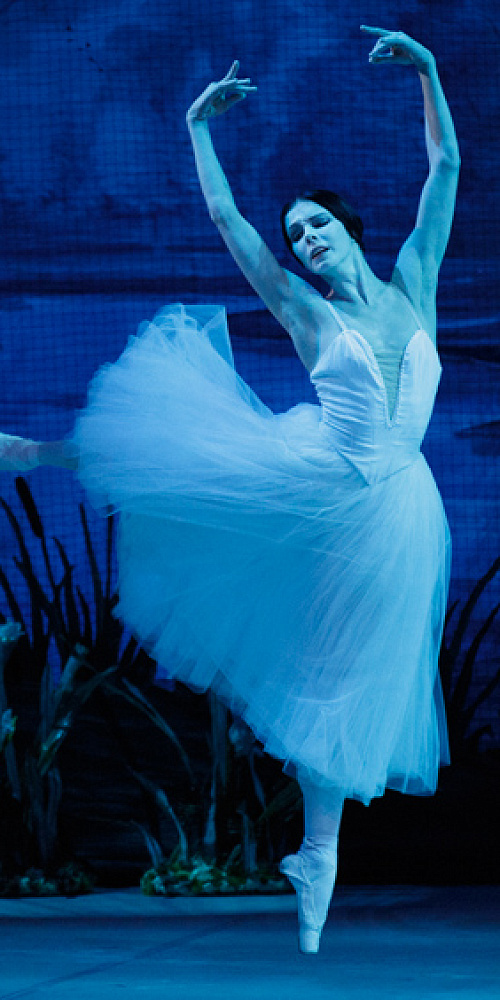BWW Reviews: The Mikhailovsky Ballet in Giselle
The Mikhailovsky Ballet is on its first United States tour and is now at the David H. Koch Theater at Lincoln Center through November 23. The Company features several of Russia's greatest dancers: Natalia Osipova and Ivan Vasiliev, formerly of the Bolshoi Ballet, and Leonid Sarafanov, formerly of the Mariinsky. It will surely conquer New York City and Los Angeles, and soon the rest of the world.
The Mikhailovsky Theatre of St. Petersburg opened in 1833 under the sponsorship of the Grad Duke Michael, the brother of Nicholas I of Russia. It has weathered the many upheavals and changes of Russian history and gone through several name changes. The Mikhailovsky has always maintained the great classical traditions of theatre, opera and music, and since the 1920s, ballet. Originally, the ballet company was used mainly for theatrical and operatic productions. In 1923, a young Georgy Balanchivadze (George Balanchine) choreographed the dances for a production of Rimsky Korsakov's opera The Golden Cockerel. In 1930, the ballet company came into prominence when Fyodor Lopukhov was appointed the Artistic Director of the Maly (now Mikhailovsky) Ballet.
The Mikhailovsky's latest reinvention was in 2007 when Russian businessman Vladimir Kekhman financed the renovation of the Mikhailovsky Theatre. Kekhman raised corporate and private funds to present new productions and lured the finest Russian dancers to the company.
The great ballet teacher and former Bolshoi dancer Mikhail Messerer joined the Mikhailovsky in 2009 as Ballet Master-in-Chief. He is from a great ballet family of the Bolshoi. His uncle was the legendary teacher and choreographer Asaf Messerer, and his cousin is the incomparable ballerina Maya Plisetskyaya. Messerer teaches company classes several times a week and preserves the pure and clean classical style and academic tradition of Russian ballet.
On November 11th, Giselle, ou les Wilis, starring Osipova and Sarafanov, was the company's brilliant and auspicious opening for their United States tour. Giselle is a ballet in two acts. The original choreography was by Juan Coralli and Jules Joseph Perrot. The libretto was by Vernoy de Saint-Georges, Théophile Gautier and Coralli, with music by Adolph Adam. Giselle premiered at the Paris Opera on June 28, 1841, with Carlotta Grisi as Giselle, Lucien Petipa as Count Albrecht and Adèle Dumilatre as Myrtha, Queen of the Wilis. Giselle is the most famous of the Romantic ballets, and is often referred to as the quintessential Romantic ballet. The modern Russian Giselle is different from the French 19th century production, as the ballet was revised in the 1850s and 1860s by Perrot, and in the 1880s and 1890s by Marius Petipa. However, Giselle is the still the oldest ballet that has kept much of its original choreography and text intact. The Russians have lovingly preserved the main romantic structure of the original with its contrast between reality and fantasy, giving it new energy by infusing the ballet with great emotion and spectacular dancing that makes it accessible for today's audience.
As Giselle, Osipova, with her pliant, strong, and superb feet, gorgeous port de bras, flashing turns, amazing hops on pointe, and the phenomenal ballon of her jumps that soar into the heavens, is a force of nature. Her sublime artistry, musicality and technique transport us to a ballet kingdom where she is queen. She is a goddess of the dance and one of the most important ballerinas of this or any other century. As Giselle, Osipova embodies both earth and air. Her magical second act will go down in ballet history as one of the greatest.
As the Count, Sarafanov's beautiful line, physical perfection and prodigious technique were a pure joy. He is a true danseur noble. Beyond his incredible technique, he is a superb actor. In the second act, his jumps and stunning entrechat six with their dramatic reaching-for-the-sky conclusion make him an iconic interpreter of this role.
Ekaterina Borchenko's line and the beauty of her physical proportions made a majestic and chilling Queen of the Wilis. The Peasants' Pas de Deux of the first act was delightfully danced by Veronika Ignatyeva and Andrey Yakhnyuk. Vladimir Tsal as the Gamekeeper was splendid both in his acting and his dancing to his death in the second act.
Messerer places great importance on mime and character dance, and the entire company's dancing and acting were exceptional. What often is stilted and boring in many companies' first act of Giselle comes to vivid life with the Russians. The acting of every dancer onstage is fully realized, and the character dancing is buoyant and exciting.
Nikita Dolgushin's gorgeous staging is earthy and realistic in the first act, and ghostly and evocative in the second. His tableaux are breathtaking. The costumes and set designs are beautifully rendered by Vyacheslav Okunev. The orchestra was sublimely conducted by Pavel Klinichev.
Every performance of the Mikhailovsky Ballet will be a must-see. They are presenting, in addition to Giselle, the full-length ballets Don Quixote and Flames of Paris, and a triple bill of Asaf Messerer's Class Concert, Marius Petipa's Le Halte de cavalerie and Nacho Duato's Prelude. Run, if you can still get a ticket, to see the Mikhailovsky Ballet, presenting Russian ballet in all of its past and present glory.
By Holly Kerr, www.broadwayworld.com



